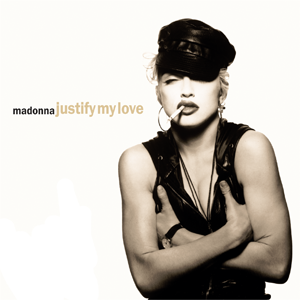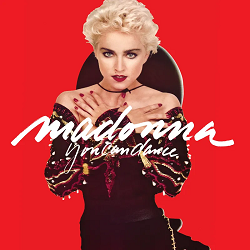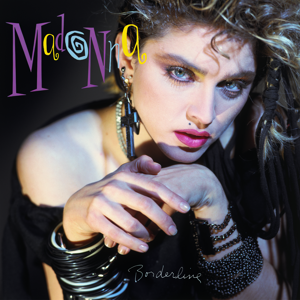
"Justify My Love" is a song released as a single by American singer Madonna. It does not appear on any of her studio albums, but is included on her first greatest hits album, The Immaculate Collection (1990). The song was written by Lenny Kravitz and Ingrid Chavez, with additional lyrics by Madonna; Kravitz also handled the production alongside André Betts. It was released as the lead single from The Immaculate Collection on November 6, 1990, by Sire and Warner Bros. Records. Chavez was not credited on the song, which led to a lawsuit against Kravitz, eventually reaching an out-of-court settlement. Musically considered as a hip hop, dance, trip hop, and experimental pop track, it features spoken word vocals by Madonna as she releases her inner freak, touching on sexual fantasies and implying the position of a woman as the one sexually in control.

You Can Dance is the first remix album by American singer and songwriter Madonna. It was released on November 17, 1987, by Sire Records. The album contains remixes of tracks from her first three studio albums—Madonna (1983), Like a Virgin (1984) and True Blue (1986)—and a new track, "Spotlight". In the 1980s, remixing was still a new concept. The mixes on You Can Dance exhibited a number of typical mixing techniques. Instrumental passages were lengthened to increase the time for dancing and vocal phrases were repeated and subjected to multiple echoes. The album cover denoted Madonna's continuous fascination with Hispanic culture.

Erotica is the fifth studio album by American singer Madonna, released on October 20, 1992, by Maverick and Sire Records. The album was released simultaneously with Madonna's first book publication Sex, a coffee table book containing explicit photographs of the singer, and marked her first release under Maverick, her own multimedia entertainment company. For the album, the singer enlisted Shep Pettibone and André Betts, with whom she had collaborated on 1990's "Vogue" and The Immaculate Collection.

The Immaculate Collection is the first greatest hits album by American singer Madonna, released on November 13, 1990, by Sire Records. It contains fifteen of her hit singles recorded throughout the 1980s, as well as two brand new tracks, "Justify My Love" and "Rescue Me". All the previously released material were reworked through the QSound audio technology, becoming the first ever album to use it. Meanwhile, the new material saw Madonna working with Lenny Kravitz and Shep Pettibone. The album's title is a pun on the Immaculate Conception, a Marian dogma of the Catholic Church.

"Causing a Commotion" is a song by American singer Madonna from the soundtrack album to the 1987 film Who's That Girl. It was released as the album's second single on August 25, 1987, by Sire Records. Its Silver Screen Single Mix later appeared on the EP The Holiday Collection (1991). Written and produced by Madonna and Stephen Bray, the song was inspired by her relationship with then-husband Sean Penn, and his abusive and violent nature. Containing a dance-oriented, up-tempo groove, the song begins with the chorus and is accompanied by a four-note descending bassline and staccato chords in the verses.

"Lucky Star" is a song by American singer Madonna from her self-titled debut studio album (1983). Produced by Reggie Lucas, it was written by Madonna with the intention that her friend Mark Kamins would play it in his sets at Danceteria, where he was the resident DJ. In 1982, Madonna was signed on by Sire Records for the release of two 12" singles; after the success of first single "Everybody", the label approved the recording of an album, and the singer decided to work with Lucas. However, problems between Madonna and the producer arose and he ended up leaving the project; she then called John "Jellybean" Benitez, her boyfriend at the time, to work on the remaining songs.

"Borderline" is a song by American singer Madonna from her debut self-titled studio album (1983), written and produced by Reggie Lucas. In 1982, Madonna was signed on by Sire Records for the release of two 12-inch singles; after the success of first single "Everybody", the label approved the recording of an album, and the singer decided to work with Lucas. "Borderline" is a pop song with post-disco elements whose sounds recall the music of the 1970s, while the lyrics find a woman complaining of her lover's chauvinism.

"Holiday" is a song by American singer Madonna from her self-titled debut album (1983). It was written by Curtis Hudson and Lisa Stevens-Crowder for their own musical act Pure Energy, and produced by John "Jellybean" Benitez. Hudson came up with the lyrics of the song while watching negative news on television, and together with Stevens-Crowder worked on the music. They recorded a demo, which was turned down by their label Prism Records. Afterwards, Benitez pitched the track and offered it to several artists, including former The Supremes singer Mary Wilson, but it was rejected. Around the same time, Benitez was working with Madonna on her album; after realizing they needed a song for the project, Benitez thought of "Holiday" and approached Hudson and Stevens-Crowder.

"Into the Groove" is a song recorded by American singer Madonna, and featured on the 1985 film Desperately Seeking Susan. Written and produced by both Madonna and Stephen Bray, the main inspiration behind the song was the dance floor; the singer wrote it while watching a Latin American man to whom she was attracted. Its instrumentation features synthesizers and drum machines, with Madonna's voice being double tracked on the chorus. Sexual innuendos and undertones are present throughout the lyrics, which are written as an invitation to dance with the singer. Originally written for her friend Mark Kamins, Madonna later decided to use it on the film, as one of the scenes needed a dance song. It was later added to the 1985 international re-issue of her second studio album, Like a Virgin (1984), and remixed for her compilations You Can Dance (1987), The Immaculate Collection (1990), and Finally Enough Love: 50 Number Ones (2022).

"Fever" is a song written by Eddie Cooley and Otis Blackwell, who used the pseudonym "John Davenport". It was originally recorded by American R&B singer Little Willie John for his debut album, Fever (1956), and released as a single in April of the same year. The song topped the Billboard R&B Best Sellers in the US and peaked at number 24 on the Billboard pop chart. It was received positively by music critics and included on several lists of the best songs when it was released.

"Vogue" is a song by American singer Madonna from her soundtrack album, I'm Breathless (1990). Written and produced by herself and Shep Pettibone, it was inspired by voguing, a dance which was part of the underground gay scene in New York City. The song was released as the lead single from the album on March 20, 1990, by Sire Records and Warner Bros. Records. "Vogue" is a house song with influences of disco, which contains escapist lyrics describing the dance floor as "a place where no boundaries exist". Its middle eight features Madonna name-dropping several actors from the Golden Age of Hollywood. "Vogue" was later included on three of Madonna's compilation albums: The Immaculate Collection (1990), Celebration (2009), and Finally Enough Love: 50 Number Ones (2022).

"Rescue Me" is a song by American singer Madonna from her first greatest hits album, The Immaculate Collection (1990). Written and produced by Madonna and Shep Pettibone, the song was released as the second single from The Immaculate Collection on February 26, 1991, in the United States, and as the third single on April 7 in the United Kingdom. A dance-pop and gospel-house track, the song is accompanied by the sound of thunder and rain, with the lyrics talking of romantic love rescuing the singer.

"Erotica" is a song by American singer Madonna from her fifth studio album of the same name (1992). It was written and produced by both Madonna and Shep Pettibone, with additional writing from Anthony Shimkin. In Australia and most European countries, the song was released as the album's lead single on September 29, 1992; in the United States, it was set to be released the following day, but after being leaked and played on several radio stations, the release date was held back until October 13. The song continued Madonna's exploration of spoken word vocals, which she had introduced in "Justify My Love" (1990). A pop hip-hop and dance song with Middle Eastern influences, its lyrics talk about sadomasochism, with the singer using the alter ego Dita and inviting her lover to be submissive while she makes love to him.

"Bye Bye Baby" is a song recorded by American singer and songwriter Madonna, for her fifth studio album Erotica (1992). It was released on November 15, 1993, as the sixth and final single from the album only outside the US. "Bye Bye Baby" was written by Madonna, Shep Pettibone, and Anthony Shimkin and was produced by Madonna and Pettibone. The song is inspired by Madonna's emotions of that time and her S&M thoughts. Musically, it is a hip hop song, sampling a hook from LL Cool J's track "Jingling Baby", released in 1990. Madonna's vocals were filtered to make them appear as sound coming out from an answering machine. "Bye Bye Baby" features instrumentation from keyboard and lyrically finds Madonna asking questions to a lover she is about to abandon.

"Deeper and Deeper" is a song by American singer Madonna from her fifth studio album, Erotica (1992). It was written and produced by both Madonna and Shep Pettibone, with additional writing from Anthony Shimkin. In Australia and most European countries, the song was released as the album's second single on November 17, 1992; in the United States, a release was issued on December 8. It was included on Madonna's second greatest hits compilation, GHV2 (2001). A dance-pop and deep house song, it has disco and Philadelphia soul influences; the bridge features instrumentation from flamenco guitars and castanets, and features background vocals from the singer's collaborators Donna De Lory and Niki Haris. Lyrically, the song talks about sexual desire, though it has been argued that it is actually about a young man coming to terms with his homosexuality, and includes a reference to Madonna's single "Vogue" (1990).

"Bad Girl" is a song by American singer and songwriter Madonna from her fifth studio album, Erotica (1992). It was written and produced by both Madonna and Shep Pettibone, with additional writing from Anthony Shimkin, and released by Maverick, Sire and Warner. In Australia and most European countries, the song was released as the album's third single on February 2, 1993; in the United States, a release was issued on March 11. "Bad Girl" is a pop and R&B ballad with lyrics that describe a woman trying to escape her reality through self-destructive behaviors, such as drinking and chain smoking.

"Rain" is a song by American singer Madonna from her fifth studio album, Erotica (1992), released by Maverick, Sire and Warner. Written and produced by Madonna and Shep Pettibone, in Australia and most European countries, the song was released as the album's fifth single on July 17, 1993; in the United States, a release was issued on August 5. A pop ballad that mixes elements of R&B, trip-hop, and new-age music, its lyrics liken water and rainfall to the power of love.

American singer Madonna has released 79 music videos, eleven concert tour videos, two documentary videos, four music video compilations, two music video box sets, four promotional videos, and four video singles. Nicknamed as the "Queen of Videos" or "Queen of MTV", her music videos were often considered by critics as works of art, depicting various social issues. Her early videos also received a significant academic attention. Madonna has won 20 MTV Video Music Awards, including the 1986 Video Vanguard Award for which she became the first female honoree. In 2003, MTV named her "The Greatest Music Video Star Ever", saying "Madonna's innovation, creativity and contribution to the music video art form is what won her the award." In 2020, Billboard ranked her at the top of their list "100 Greatest Music Video Artists of All Time".

"This Used to Be My Playground" is a song recorded by American singer Madonna. It is the theme for the film A League of Their Own, which starred Madonna, and portrayed a fictionalized account of the real-life All-American Girls Professional Baseball League. Madonna was asked to record a song for the film's soundtrack. At that time she was busy recording her fifth studio album, Erotica, with producer Shep Pettibone. They worked on some ideas and came up with "This Used to Be My Playground" in two days. Once presented to director Penny Marshall's team, the song was released as a standalone single on June 16, 1992, by Warner Bros. Records. However, it was not available on the film's soundtrack due to contractual obligations and was later added to the Olympics-inspired Barcelona Gold compilation album, released that summer. The song was included on Madonna's 1995 ballads compilation Something to Remember.

The Video Collection 93:99 is the third music video compilation by American singer-songwriter Madonna. Released by Warner Music Vision, Warner Reprise Video and Warner Bros. Records on November 9, 1999, it contained music videos for singles released between 1993 and 1999. Originally, the collection was titled The Video Collection 92–99, and had included the 1992 video "Erotica", but it was omitted due to its sexually explicit content; instead the 1998 song "The Power of Good-Bye" was added. The videos in the collection were selected personally by Madonna, who felt the 14 videos to be her best work.




















